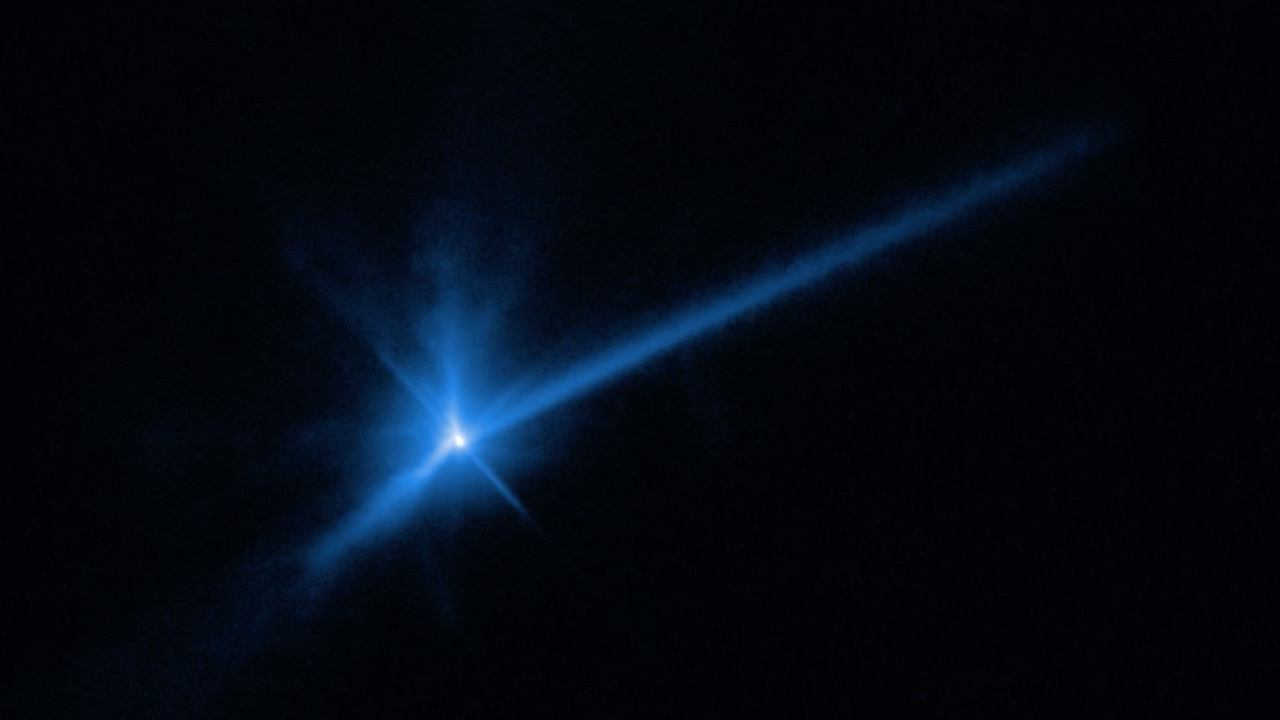Here's what we've learned from NASA's DART asteroid-slamming mission so far
Scientists revealed the extent of the impact DART had on its targets Dimorphos and Didymos, including the "amazing" amount of material it blasted away.

The DART mission, NASA's first attempt to prove whether it is possible to shift an asteroid away from a collision course with Earth, has been described as a "great success" by scientists involved in the project.
The target asteroid system of DART, or the Double Asteroid Redirection Test, was the 2,560-foot (780 meters) wide space rock Didymos and its smaller orbiting "moonlet" Dimorphos, just 530 feet (160 m) in diameter. The DART mission impacted Dimorphos on Sept. 26, 2022, with the impact and its aftermath observed by numerous ground-based observatories, as well as space-based instruments like the Hubble Space Telescope and the James Webb Space Telescope (JWST). DART's impact was also followed by the LICIACube spacecraft, which traveled to Dimorphos and Didymos aboard DART.
"DART was a smashing success," Andy Rivkin, a researcher at the Johns Hopkins University Applied Physics Laboratory (APL), said as he and other DART researchers presented the results of the mission at the 8th Planetary Defense Conference in Vienna, Austria, on Monday (April 3). During the first session of the conference, which was also presented online, the team detailed the effect of the impact on the asteroid system's orbit and its velocity and described the plume of ejected material blasted away from the moonlet by the strike.
Related: Asteroid apocalypse: How big must a space rock be to end human civilization?
The success of the mission was emphasized by DART mission systems engineer Elena Adams, also of APL. She revealed that the spacecraft managed to strike Dimorphos within just 82 feet (25 m) of its target, the geometric center of the moonlet. Adams elaborated on how challenging this was given the speed the craft was traveling at, and the fact that its trajectory was shifted during the final moments of its rapid approach to the asteroid system.
"We actually steered DART towards Didymos for 10 months, and then only at 50 minutes from impact did we start going towards Dimorphos. So, just to give you a feel for it: We were moving at 14,000 miles an hour [22,530 kph]," Adams said. "You're going really fast and you have very little time to actually make any changes. But, the asteroid remained contained in our field of view the whole time. We were dead center on the whole time, and that was a wonderful feeling."
Measuring the impact of DART
One of the most important effects on the asteroid system that the DART impact had was to the change of the orbital period of Dimorphos around Didymos. Before the impact, Dimorphos completed one lap around Didymos in around 11 hours and 55 minutes. The DART collision reduced the length of this period by around 33 minutes.
Breaking space news, the latest updates on rocket launches, skywatching events and more!
The shape of the moonlet's orbit around its parent body was also altered by the strike. Prior to being hit by DART, observations of the Dimorphos/Didymos system made between 2003 and 2022 showed that the smaller body followed an orbit around its larger companion that was almost perfectly circular, according to Shantanu Naidu of NASA's Jet Propulsion Laboratory. He added that, after the impact of DART, the orbit of Dimorphos now has the shape of a flattened circle, or ellipse. The overall change was around 2%.
The change in orbit was a result of the alteration of the velocity of Dimorphos caused by the impact, with the rock now traveling at around 2.7 millimeters per second more slowly than it did before the collision, according to Harrison Agrusa a Postdoctoral Researcher at Observatoire de la Côte d'Azur. These are only small changes, but in a real Earth-threatening scenario, such shifts could help divert an asteroid on a collision course as long as scientists get enough advance warning of its approach.
One of the most spectacular and visible consequences of the impact of DART upon Dimorphos were the jets of material or "ejecta" that the collision blasted away. The ejecta have been tracked by both telescopes on Earth and Hubble and Webb from their vantage points in space.

"You can see these rays of material coming off out of the system, streaming out and acting like the rays on the moon, except, instead of falling back on the moon, they escape into space," Rivkin said. "We think the amount of material in the tail is something like 10 million kilograms [22 million pounds] at this point, which would be something like 60 rail cars. It's just amazing to me that we get that much material that looks so striking coming out of an object that's really only the size of a big building."
The tail of the material shaken loose by the impact persisted for months after the encounter between DART and Dimorphos, and Rivkin pointed out it is still visible in the latest data collected from the system. This ejecta is also helping to shift the trajectory of the asteroid system and will be monitored for months to come.
"We are going to continue to monitor it with the Hubble Space Telescope and ground-based telescopes as long as we can and see if we can watch the evolution of the tail from start to finish," he added.
DART learned more about its asteroid target
In addition to violently altering the path of Dimorphos around Didymos, the DART mission was able to collect important details about the asteroid system, which means it could have a considerable impact on our scientific understanding as well.
"We knew very little about Dimorphos itself, and that was part of the challenge of this mission," Adams said. "We wanted to know what Dimorphos looks like."
The appearance of the surface of Dimorphos was recorded by DART's only scientific instrument, the Didymos Reconnaissance and Asteroid Camera for Optical navigation (DRACO). DRACO imaged the surface of the moonlet as DART hurtled toward it, capturing its final image just seconds prior to impact. It is clear from these images that the appearance of Dimorphos isn't quite what the team expected.
"[Dimorphos] does not look like, you know, kind of your typical movie depiction of a rugged, craggy sort of thing. So we were all very surprised in some ways at its appearance," Rivkin said. "This is now going to set the paradigm for what we think 150-meter sized objects look like, at least until the next visit to a 150-meter asteroid."
The images were so detailed that researchers have been able to identify several specific rocks and craters across the moonlet's surface, which were all named after percussion instruments because, as Rivkin puts it, DART smacked Dimorphos like a drum. Which of these features remained after the DART impact is uncertain. From the ejecta now following the asteroid system, scientists have also been able to determine that the moonlet Dimorphos is very close in composition to its parent body Didymos.
Prior to the DART impact, the moonlet Dimorphos was tidally locked to its parent body, behaving just like Earth's moon, which constantly faces its planet with the same side. The DART team doesn't yet know whether the impact changed that tidal locking.
"There are basically three possible scenarios: One, Dimorphos remains tidally locked, but liberates back and forth with an amplitude of tens of degrees, just like the moon liberates with an amplitude of about one degree," Agrusa explained. "The other two options are that Dimorphos has broken from a synchronous rotation entirely and rotates at a period of something like 13 hours while it orbits around Dimorphos in 11.5 hours. And then the third option is that it has entered some kind of an altitude instability where it's in a chaotic tumbling state, tidally locking for a period of time and then breaking from tidal locking."
Asteroid Impact and Deflection Assessment team leader, Patrick Michel, highlighted some of the other questions that researchers will now seek to answer about Dimorphos, such as what is the mass, density and cohesiveness of the body. Only when these things are known will the full impact of DART be understood.
These remaining questions will potentially be answered when the European Space Agency's spacecraft Hera reaches the asteroid and its moonlet at the end of 2026. Hera's primary mission will be to measure the final effect of the DART impact and to collect data that will help convert this mission from a "proof of concept" to a viable planetary defense system.
Follow us on Twitter @Spacedotcom or on Facebook.

Robert Lea is a science journalist in the U.K. whose articles have been published in Physics World, New Scientist, Astronomy Magazine, All About Space, Newsweek and ZME Science. He also writes about science communication for Elsevier and the European Journal of Physics. Rob holds a bachelor of science degree in physics and astronomy from the U.K.’s Open University. Follow him on Twitter @sciencef1rst.
